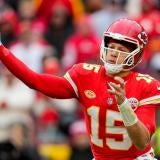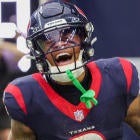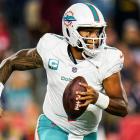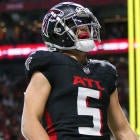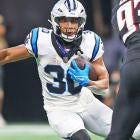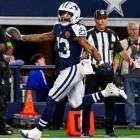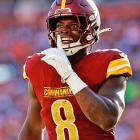Since the turn of the century, eight wide receivers posted 1,000 yards as a rookie. Three of those eight came in 2014. And five rookie wideouts had nine or more touchdowns -- and again, three of those came last year.
Suddenly, receivers aren't waiting until their second or third years to break out. Last season we saw two rookies finish in the Top 12 in standard Fantasy play, two more in the Top 24 and another first-year wideout finish 25th among receivers. It's evidence pointing toward rookie wideouts contributing to Fantasy as quickly as their rushing counterparts.
Now that Mike Evans, Kelvin Benjamin, Jordan Matthews, Sammy Watkins and, most importantly, Odell Beckham have had that breakout campaign, is it right to have high expectations for their second seasons?
History lesson
Before looking at this year's crop of second-year receivers, let's review what's happened to second-year receivers since 2000. We found 149 receivers who posted decent stats in one of their first two years. We're talking at least 400 yards and/or three touchdowns. Nothing big.
Of the 149 ...
109 improved (73.1 percent)
32
declined (21.5 percent)
8 stayed about the same (5.4
percent)
Before lighting off fireworks in celebration, let's make clear that this includes stiffs you wouldn't have come near your Fantasy team. Guys like Bobby Wade and Rishard Matthews. Comparatively speaking, rookies like Taylor Gabriel and Davante Adams put up numbers that would have qualified them for this grouping.
Let's up the ante a little bit. What about receivers who had 100 or more Fantasy points as a rookie? Players with something like 700 yards and five touchdowns or 600 yards and seven touchdowns? There weren't a lot in the last 14 years -- only 32 receivers hit at least those marks as rookies.
Of the 32 ...
17 improved (53.1 percent)
13
declined (40.6 percent)
2 stayed about the same (6.3
percent)
The results still favor receivers going from Year 1 to Year 2, but it's not nearly as rosy as when we looked at any rookie wideout. Martavis Bryant, Sammy Watkins and Jordan Matthews figure to be comparable receivers to this study based on how they did as rookies.
Let's take it one step further and look at the best of the best. How did rookie receivers from 2000-2014 who put up big numbers do in their second seasons? Guys from Roy Williams (817 yards and eight touchdowns) to A.J. Green (1,350 yards and 11 touchdowns)?
There were only nine of them.
Of the 9 ...
3 improved (33.3 percent)
6 declined
(66.7 percent)
*insert sound of a needle scratching a record here*
That's not cool. But before we affix this 66.7 percent fail rate to productive rookies, it's worth a shot to look over what actually happened to the six wideouts who took a fall after a big first year.
Anquan Boldin, 49ers
Rookie year: 101 catches, 1,377
yards, eight touchdowns
Second year: 56 catches, 623 yards,
one touchdown
Why? An injury cost him six games and the
addition of Larry Fitzgerald changed his
role. But poor quarterback play really did him in.
Worth noting:
Boldin had a fantastic third season and has remained relevant for years.
Lee Evans
Rookie year: 48 catches, 843 yards, nine touchdowns
Second
year: 48 catches, 743 yards, seven touchdowns
Why? Evans'
quarterback situation changed for the worse and he started earning more
attention than other Bills receivers.
Worth noting: Evans'
third season was his best (with J.P. Losman and a new coaching staff)
but fell off soon after.
Michael Clayton
Rookie year: 80 catches, 1,193 yards, seven
touchdowns
Second year: 32 catches, 372 yards, zero touchdowns
Why?
Clayton was a rookie hero because the Bucs lost veterans Joey Galloway and Joe Jurevicius. Galloway was back a season later
and sent Clayton back to being second banana. Offseason knee surgery
didn't help Clayton, nor did his quarterback situation.
Worth
noting: After his rookie year, Clayton failed to record even 500
yards in a season and totaled three touchdowns over his last 79 games.
Mike Williams
Rookie year: 65 catches, 964 yards, 11 touchdowns
Second
year: 65 catches, 771 yards, three touchdowns
Why? Tampa
Bay's offense went kablooey in 2011 as Josh Freeman and Mike Williams both
regressed on and, reportedly, off the field.
Worth noting:
Williams rebounded in his third season, catching a career-best 996 yards
on 63 grabs with nine touchdowns, working as the No. 2 receiver with Vincent Jackson in 2012. His career fell off a cliff after that.
Roy Williams
Rookie year: 54 catches, 817 yards, eight
touchdowns
Second year: 45 catches, 687 yards, eight touchdowns
Why?
Detroit improved their receiving corps in 2005 but Williams still drew
tougher coverage. The Lions also had Joey Harrington.
Worth noting: His third year was his best
year, notching 1,310 yards on 82 catches (both career-highs) with seven
touchdowns. His numbers went downhill after that.
Keenan Allen, Chargers
Rookie year: 71 catches, 1,046
yards, eight touchdowns
Second year: 77 catches, 783 yards,
four touchdowns
Why? Allen was pretty much the only receiving
threat the Chargers had as a rookie. Last year, Malcom Floyd came back and Antonio Gates
re-emerged.
Worth noting: Allen did get hot in late November
before injuries ended his 2014 season early.
What really stands out here? Five of the six receivers listed above had below-average quarterback play in their second seasons and four of five rebounded in their third seasons --Allen's third season is coming up after a regression, but he has a capable quarterback in Philip Rivers. Hmm.
Keep those takeaways in mind when you preview these second-year receivers and find out who might be a candidate for a down year. Also note: bust potential is based on draft position and overall contributions to your Fantasy team.
Odell Beckham, Giants
Rookie year: 91 catches,
1,305 yards and 12 touchdowns in 12 games
Bust potential: Low.
Beckham has a very capable quarterback in Eli Manning and the offensive scheme isn't changing. Really, it
will come down to how defenses try to contain Beckham and how often he
makes them pay when their coverage breaks down. It wouldn't be a shock
to see Beckham deliver similar numbers over 16 games. I especially like
that he's taking his offseason work seriously.
Draft value:
Top 20 pick
Mike Evans, Buccaneers
Rookie year: 68 catches,
1,051 yards and 12 touchdowns
Bust potential: Medium. Evans
made some amazing catches last year despite playing with some
not-so-appealing quarterbacks. With signs pointing to the Bucs drafting
Jameis Winston, he'll again be in a spot where the quarterback spot
isn't a cinch. It helps that Vincent Jackson
will help keep defensive coverage from badgering Evans for 16 weeks.
Draft
value: Top 30 pick
Kelvin Benjamin, Panthers
Rookie year: 73
catches, 1,008 yards and nine touchdowns
Bust potential: Medium.
The Panthers should take some significant steps to upgrade their passing
corps and that could ease the double-teams. Benjamin can't drop as many
passes as he did last year or else he could end up producing worse
totals.
Draft value: Top 40 pick
Sammy Watkins, Bills
Rookie year: 65 catches, 982
yards and six touchdowns
Bust potential: Medium. It's Watkins'
pure talent that keeps him appealing for Fantasy. The expectation is
that a conservative offense along with weakish quarterbacks will hold
Watkins back. Matt Cassel has a good
track record of taking his top receivers and turning them into Fantasy
stallions (he did it with Dwayne Bowe
twice and with Wes Welker and Randy Moss
once each). Greg Roman's offense didn't spawn a lot of 1,000-yard
receivers and neither did Rex Ryan's guys while with the Jets. It's a
matter of how much Cassel will play and how effective he'll be (and if
he throws a lot).
Draft value: Top 60 pick
Jordan Matthews, Eagles
Rookie year: 67 catches,
872 yards and eight touchdowns, and that includes a mostly slow start
Bust
potential: Medium. It looks like there will be some concern over the
quarterback situation in Philly. Will it be Sam Bradford? Will they
trade up for a rookie? Do any of those solutions inspire confidence?
More importantly, with Jeremy Maclin
out of the picture, it will almost certainly be tougher for Matthews to
be way more impactful than he was as a rookie.
Draft value:
Between Rounds 6 and 8
Jarvis Landry, Dolphins
Rookie year: 84 catches,
758 yards and five touchdowns
Bust potential: Low. The
Dolphins have seemingly paved the way for Landry to get more targets and
catches in 2015 and they have a quarterback who is comfortable in their
offensive system. He should be in play to wrangle a slew of catches and
fall into better numbers than he did as a rookie with limited playing
time. He'll be a safe pick but I'm just not sure the upside is as huge
as it is for other rookies.
Draft value: Between Rounds 7 and 9
John Brown, Cardinals
Rookie year: 48 catches,
696 yards and five touchdowns
Bust potential: High. With Michael Floyd and Larry Fitzgerald
still a part of the Cardinals passing game, Brown's opportunities will
remain limited. It might be 2016 before we see Brown really take off.
Draft
value: Between Rounds 8 and 10
Allen Hurns, Jaguars
Rookie year: 51 catches, 677
yards and six touchdowns
Bust potential: High. A change in
offensive coordinators won't help Hurns, nor will seeing teammates Allen Robinson and Marqise Lee get
better acclimated to the same new scheme (which won't favor the deep
ball). Hurns figures to remain inconsistent.
Draft value:
Late-round pick
Taylor Gabriel, Browns
Rookie year: 36 catches,
621 yards and one touchdowns
Bust potential: High. Bank on the
Browns adding to their receiving corps, likely capping any role Gabriel
has in 2015.
Draft value: Undrafted
Brandin Cooks, Saints
Rookie year: 53 catches,
550 yards and three touchdowns in 10 games
Bust potential: High.
Cooks seemed to especially show up playing indoors on the turf that
better suited his speed. I'm expecting the Saints to be more creative
with him, but it remains to be seen if he develops into the next Randall Cobb or Percy Harvin ... or Donnie Avery. At least he has the quarterback to help him level out
the risk and reward.
Draft value: Between Rounds 6 and 8
Martavis Bryant, Steelers
Rookie year: 26
catches, 549 yards and eight touchdowns
Bust potential: Medium.
It's hard to catch a touchdown every 3.25 catches, but that's what
Bryant did last season. Bryant proved to be more than a deep threat but
I have some reservations on whether or not he can perform as an
every-down receiver. He's going to be a frustrating player to own in
Fantasy.
Draft value: Between Rounds 7 and 9
Allen Robinson, Jaguars
Rookie year: 48 catches,
548 yards and two touchdowns in 10 games
Bust potential: Low.
Robinson has the size and hands to rack up plenty of stats. Staying
healthy is obviously a factor for him after fracturing his foot last
year, but he should be counted on as the steadiest Jaguars receiver in
2015. Whether or not that means amazing numbers remains to be seen, but
65-plus catches should be a lock.
Draft value: Late-round pick
Davante Adams, Packers
Rookie year: 38 catches,
446 yards and three touchdowns
Bust potential: Low. If
defenses are worried about getting burned deep by Jordy Nelson or shallow by Randall Cobb,
how will they spend resources to cover Adams? He might end up being as
inconsistent as he was last season (two games with over 100 yards in his
final 10 games, eight with 13 yards or fewer) but he certainly should
contribute more than a single catch per week.
Draft value:
Between Rounds 8 and 10
Donte Moncrief, Colts
Rookie year: 32 catches,
444 yards and three touchdowns
Bust potential: Medium.
Indianapolis' receiving corps has automatic potential just because of Andrew Luck at quarterback, and because T.Y. Hilton will draw lots of
attention, Moncrief will definitely get opportunities. He just has to
keep up his end of the bargain or else Duron Carter could usurp his snaps.
Draft value: Between
Rounds 8 and 10
Marqise Lee, Jaguars
Rookie year: 37 catches, 422
yards and one touchdown
Bust potential: High. Lee needs to
make a big jump this offseason to morph into the prolific receiver he
was in his first two years at Southern Cal. The guy he hasn't been for
the last two years. The plus is that he has excellent speed and could
capitalize on soft coverage. There's a lot of risk-reward, but the price
isn't bad.
Draft value: Late-round pick
Five receivers who could break out in their second year: Cody Latimer (Broncos), Josh Huff (Eagles), Chris Matthews (Seahawks), Albert Wilson (Chiefs), Bruce Ellington (49ers)







